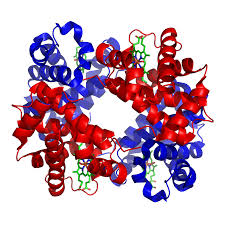hemoglobin
英 [ˌhiː.məˈɡləʊ.bɪn]
美 [ˌhiː.məˈɡloʊ.bɪn]
- n. [生化] 血红蛋白(等于haemoglobin);血红素

记忆方法
记忆“hemoglobin”这个单词可以通过以下简单方法:
1. 分解记忆:“hemo-”与血液相关,“globin”类似于“glue”或“glueball”,想象血液中的“粘合球”。
2. 形象记忆:将“hemo”想象为“血”(血红色),然后是“globin”如球状,就像是血液中的红细胞(富含血红蛋白)。
3. 联想记忆:将“hemo”和“globin”组合起来,想象为血液中的“红色球体”,即红细胞,它是含有血红蛋白的细胞。
1. 分解记忆:“hemo-”与血液相关,“globin”类似于“glue”或“glueball”,想象血液中的“粘合球”。
2. 形象记忆:将“hemo”想象为“血”(血红色),然后是“globin”如球状,就像是血液中的红细胞(富含血红蛋白)。
3. 联想记忆:将“hemo”和“globin”组合起来,想象为血液中的“红色球体”,即红细胞,它是含有血红蛋白的细胞。
以上内容由AI生成, 仅供参考和借鉴
英语词源
- hemoglobin (n.)
- coloring matter in red blood stones, 1862, shortening of hæmatoglobin (1845), from Greek haimato-, comb. form of haima (genitive haimatos) "blood" (see -emia) + globulin, a type of simple protein, from globule, formerly a word for "corpuscle of blood."
权威例句
- 1. Hemoglobin can also be cross - linked to solublepolymers to form so - called conjugated hemoglobin.
- 血红蛋白也能交联到水溶性多聚体上,形成 所谓 的共轭血红蛋白.
- 2. The occurrence of hemoglobin in root nodules is notable.
- 值得注意的是根瘤中出现血红蛋白.
- 3. The effects are dependent upon the combination of carbon monoxide with hemoglobin to form carboxyhemoglobin.
- 这种影响取决于一氧化碳同血红蛋白结合而生成的一氧化碳血红蛋白.
- 4. Each molecule of hemoglobin for example , assumes exactly the same shape to the smallest detail.
- 每一个血红朊分子直到最小的细微部分都具有完全相同的形状.
- 5. Monitor the level of hemoglobin and the behavior , disp of mice kineticly.
- 动态观察小鼠血红蛋白和性情、行为改变,观察无偏瘫、抽搐、出血等.